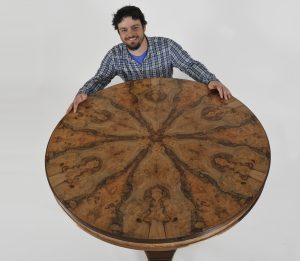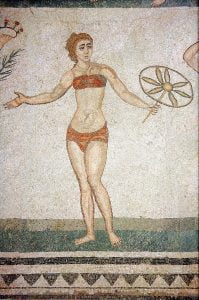Anselm Fraser, the school’s principal, writing in The Woodworker magazine
A common mistake that many woodworkers make is to spend too much time trying to create originality.
The fact is that originality is over-rated. Instead, the advice I give to my woodworking students is to simply follow their instincts, and see where it takes them.
The fact is that there is nothing new under the sun. Furniture has been around for as long as human beings have been around – and the human body hasn’t changed much.
The example I give is Skara Brae, a small Neolithic settlement on Orkney. It comprises eight dwellings and dates to between 3200BC and 2200BC.
Stone Age
But, what’s remarkable to me as a furniture maker, is that each house has beds, cupboards, dressers and shelves. It’s Stone Age furniture made from stone, because the island archipelago doesn’t have many trees.
Over the centuries, furniture designers have tinkered with Skara Brae’s original furniture designs. Over that huge span of years, we’ve ended up with beds, tables and chairs that look good and, crucially, are fit for purpose.
The American novelist Herman Melville, best known for Moby Dick, once remarked that it is better to fail in originality than to succeed in imitation. That’s very good advice.
Aim to be different, aim to create furniture that has your DNA embedded in it. Use design tweaks that make it absolutely yours. But don’t necessarily aim for utter originality, because there is nothing new under the sun.
Think instead of Robert Thompson, the British furniture maker whose career spanned the 10th and 20th centuries. He incorporated a carved mouse on virtually everything he made.
Mouseman
In furniture making, that mouse is as good as a signature. Whatever he made, everyone knew who made it. The mouse helped to turn Robert Thompson into a brand and, as any marketeer will now tell you, people buy into brands.
After more than thirty years of teaching woodworking, I have seen the good, bad and ugly of furniture design. I have seen hugely gifted students try to design the impossible and fail.
But I have also seen less gifted students simply be themselves, and let their creativity shine through in smaller ways.
That’s the kind of originality I like because it means that a student is not thinking about changing the face of furniture design. Instead, he or she is recognising that a small tweak here and there is all that’s needed. It’s about recognising their strengths and working to exploit those strengths.
After all, as Judy Garland said: “Always be a first-rate version of yourself, instead of a second-rate version of somebody else.”
Pepperwood
We had an American student last year. John Grillo from Denver, who won the Richard Demarco Prize 2018. He won it for a table (pictured below) that “transcended craftsmanship to be genuine art”, according to the renowned arts commentator.

It was a table that was well designed and crafted. It conformed in all respects to what a round dining table should look like to perform its everyday function. Except one.
John’s table was veneered with pieces of pepperwood to form a simple, flowing yet geometrically-complex design. Pepperwood is native to the south-eastern USA, and is sometimes called the toothache tree because chewing its leaves or bark causes a tingling numbness in the mouth. For that reason, it was used by Native Americans and early settlers to treat toothache.
But the use of that highly unusual veneer elevated John’s table from the ordinary to the extraordinary. It was something with real functionality but with dollops of WOW factor.
Bikini
Or take, for example, the bikini. Designed in France and unveiled in Paris in 1946, its name was inspired by a US atomic test on an atoll in the Pacific Ocean. It was hailed as something new and exciting, and swiftly became an icon of emancipation.

Except that it wasn’t, because the earliest surviving depiction of a bikini is on a mosaic found in Sicily and dating from the 4th century AD. In the intervening sixteen centuries, the bikini hadn’t changed at all.
For me, therefore, originality is an over-used concept. It implies that a piece of furniture is ground-breakingly different when, in fact, it may only have a small design flourish – a carved mouse or an unusual veneer.
But that’s what originality in furniture design is all about. Making the small things different, tinkering with a basic design and adding in a little bit of yourself.
That last bit is the most important. Woodworking should be an expression of your individual passion. What you make should reflect who you are, not an imitation of who you would like to be.
Believe me, that authenticity will shine through.
